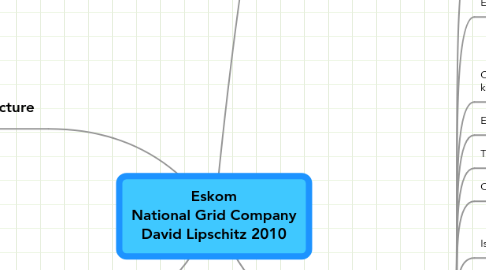
1. Eskom Structure
1.1. Generating Division
1.2. Customer Network Business Head: Erica Johnson Secretary: Colleen Helper: Lina
1.2.1. Transmission Division
1.2.2. Distribution Division
1.2.3. System Operations & Planning
1.2.3.1. 6 Regional Control Centres
1.2.3.2. Balancing Demand and Supply
1.2.3.3. Dealing with Load Shedding
1.3. Contacts
1.3.1. Andrew Etzinger
2. NERSA
2.1. Relationship with Eskom
2.1.1. Gives Eskom 2 licences
2.1.1.1. Generation
2.1.1.2. Distribution, etc
3. Parliament Talk Include
3.1. Costs
3.1.1. how easy to split?
3.2. Resources
3.2.1. Eskom's 2009 Annual Report
3.2.2. FLOE's internal research
3.2.3. IEEE web site
3.2.4. NERSA - REFIT Guidelines
3.2.4.1. Note: key elements of FIT include
3.2.4.1.1. "remove barriers to grid connection"
3.2.4.1.2. "developing an appropriate and streamlined administrative and application process"
3.2.4.2. key principles include
3.2.4.2.1. guaranteed access to the National Grid
3.2.4.2.2. guaranteed purchase price for a fixed duration
3.2.4.2.3. a willing buyer, willing seller approach
3.2.4.2.4. spreading costs across all consumers
3.3. Current Situation
3.3.1. Advantages
3.3.1.1. A single operator / utility owns most of the supply chain
3.3.1.1.1. the missing bit is where municipalities provide electricity to consumers inside their locales
3.3.1.1.2. can theoretically reduce costs across the supply chain
3.3.2. Disadvantages
3.3.2.1. Carbon taxes are going to be internalised over the next 10 to 50 years
3.3.2.2. Monopolies usually try to reduce costs as much as possible whilst trying to maximise profits as much as possible
3.3.2.2.1. this might not be in the interest of their clients
3.3.2.2.2. it might not be in the interest of the environment
3.3.2.2.3. Eskom provides 95% of South Africa's electricity
3.3.2.2.4. Eskom is 100% owned by the SA Govt
3.3.2.2.5. Eskom is the only organisation that is allowed to buy energy from IPPs
3.3.2.3. Eskom is stalling projects
3.3.2.3.1. eg: CSP in Northern Cape
3.3.2.3.2. Preventing Power Purchase Agreements from being signed
3.3.2.3.3. Preventing RE projects from going ahead
3.4. Split Situation
3.4.1. Advantages
3.4.1.1. remove conflict of interest inside Eskom
3.4.1.2. allow for retail wheeling
3.4.1.2.1. where customer and supplier are the same person
3.4.1.2.2. where customer and supplier are different people
3.4.1.3. Eskom becomes the largest (for now) IPP
3.4.1.3.1. "for now"
3.4.1.4. Gives clear Guidelines and procedures
3.4.1.4.1. a separate operator will give guidelines for allowing grid connection agreements
3.4.1.4.2. Barriers to entry will be reduced
3.4.1.4.3. Power Purchase Agreements easy to get
3.4.1.5. allows for competition
3.4.1.6. SA Govt wants to achieve 10 TWh (10,000 GWh) of electricity by 2013
3.4.1.6.1. Current Sales = 214 TWh
3.4.1.7. Private investors will invest
3.4.2. Disadvantages
3.4.2.1. possibly insecurity of supply
3.4.2.1.1. but if security includes climate change and the need for alternatives, then we have huge potential
3.5. How Eskom can achieve its goals?
3.5.1. Can Eskom achieve its goals?
3.5.2. Can Eskom meet its values?
4. Talk
4.1. FLOE
4.1.1. Introduction to FLOE and why we are at Parliament
4.2. Eskom's conflict of interest
4.2.1. Supplying what it perceives as lowest cost electricity
4.2.2. Owning the supply chain
4.2.3. Not wanting IPP's to compete with it
4.3. Capital Expenditure, Asset Values, Incomes, Costs are known per the divisions
4.4. Eskom has two main divisions
4.5. The Customer Network Business Division has a number of sub-divisions
4.6. One could therefore determine how the split could happen
4.7. Is there a precedent for the split?
4.7.1. Network Rail in the UK
4.7.1.1. Operates and maintains the railroad infrastruture
4.7.1.2. Virgin Rail, British Rail, etc run their trains on Network Rail
4.8. What is prevented by the current arrangement
4.9. The NERSA relationship
4.9.1. Responsibilities of each
4.9.1.1. NERSA as "the regulator"
4.10. Are there alternatives to the suggestion?
4.10.1. 3 debates inside Eskom
4.10.1.1. Single Buyer
4.10.1.2. Split Wires Side from Trading Side
4.10.1.3. Consolidate at the Regional Level (REDs)
4.11. Are there strategic problems with the suggestion
4.11.1. Is it in the "national interest"
4.11.2. Is is viable?
4.11.3. What about security of supply?
4.11.4. Is RE a reasonable source of electricity for base load energy, ie is it always available?
4.11.4.1. 1) having RE reduces carbon emissions
4.11.4.2. 2) does it reduce the need for base load power stations?
4.11.4.3. 3) does it reduce the need for coal and other non-renewable resources?
